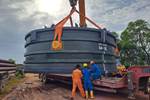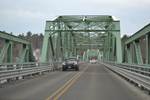Dutch partnership constructs 3D printed composite pedestrian bridges
Engineering consulting firm Royal HaskoningDHV and partners achieved a bridge design made of 30% fiberglass and 70% waste.
Architectural firm Atelier Dutch (Putten, Gelderland) in partnership with engineering consulting firm Royal HaskoningDHV (Amersfoort, Netherlands) and the municipality of Gemeente Putten, have developed a 3D printed fiber-reinforced plastic (FRP) bridge.
The project was initiated to provide two pedestrian bridges connecting an existing wooded bank in a new housing estate, Rimpeler, which has approximately 350 homes. Royal HaskoningDHV, which has been researching 3D printed bridges for a number of years, saw this as an opportunity to construct one using these fabrication methods.
The final product consists of 70% industrial waste (PET-G) and 30% glass fiber and was printed using CEAD’s (Delft, Netherlands) 3D printing technologies by toolmaker Nedcam (Heerenveen, Netherlands). Atelier Dutch designed the bridge’s intricate, 3D printed handrail. Notably, the final product is recyclable — at the bridges’ end of life, their material can be shredded down and printed again, and Nedcam often recycles this material for boat molds, among other applications. Moreover, due to its low weight, it is easy to move.
Timmer-GWW (Nijkerk) installed the bridge, and it was opened in April 2024 by alderman Bertus Cornelissen. Next steps including scaling up 3D printed bridge construction, especially with the larger printers that are now available.
For more information visit LinkedIn.
Related Content
-
Jeep all-composite roof receivers achieve steel performance at low mass
Ultrashort carbon fiber/PPA replaces steel on rooftop brackets to hold Jeep soft tops, hardtops.
-
Running shoe insoles get a lift with thermoplastic fiberglass tapes
FlexSpring insoles take advantage of unidirectional, continuous fiberglass and thermoplastics to enable next-level performance for the everyday runner.
-
Al Seer Marine, Abu Dhabi Maritime unveil world’s largest 3D-printed boat
Holding the new Guinness World Record at 11.98 meters, the 3D-printed composite water taxi used a CEAD Flexbot to print two hulls in less than 12 days.

















